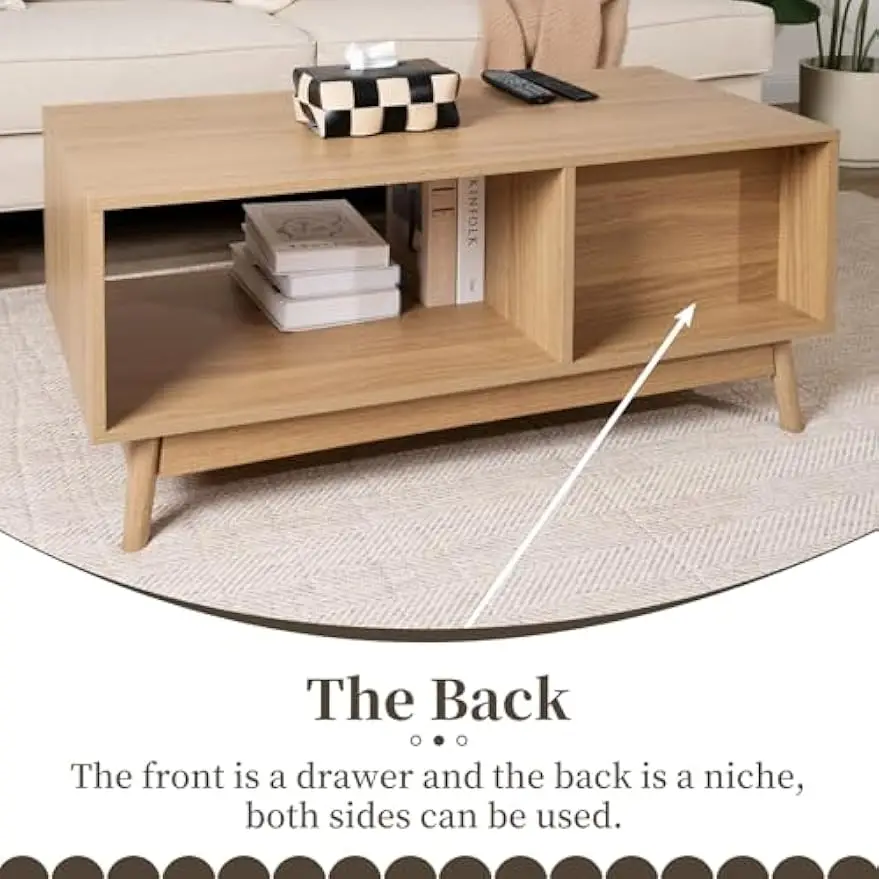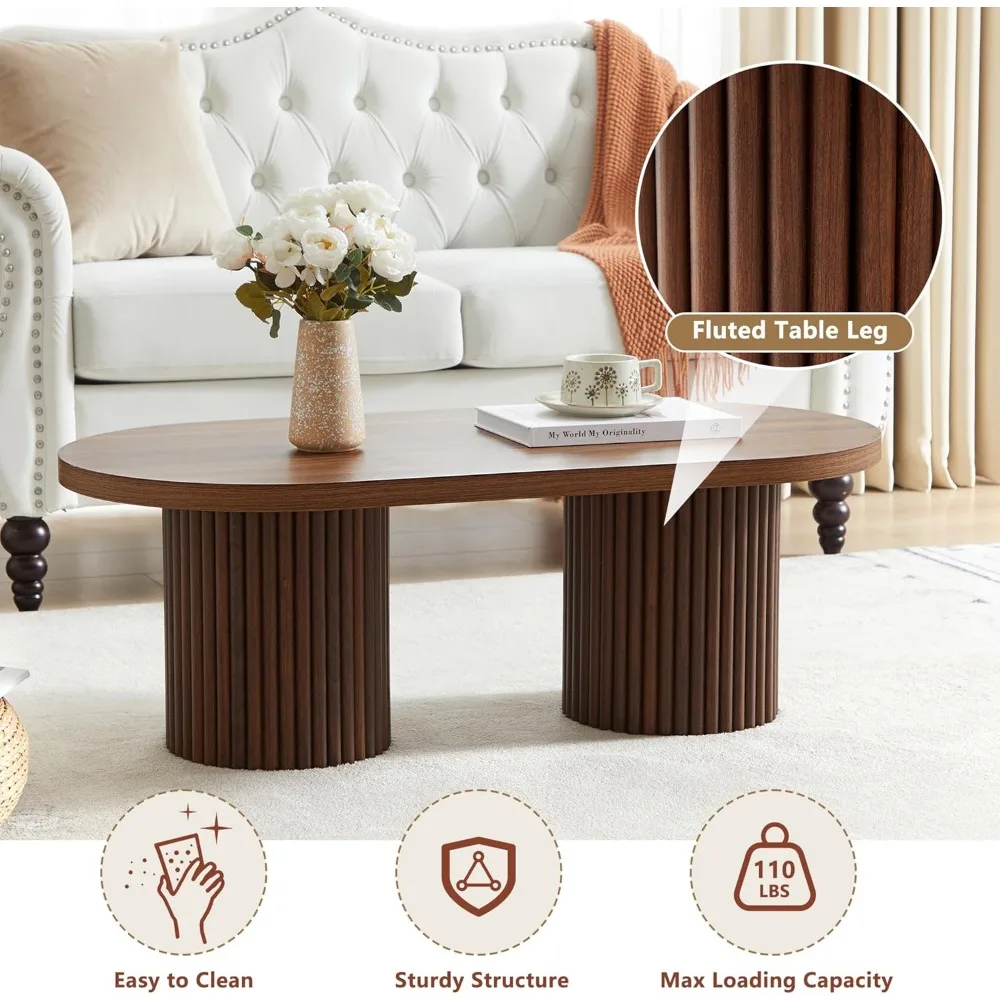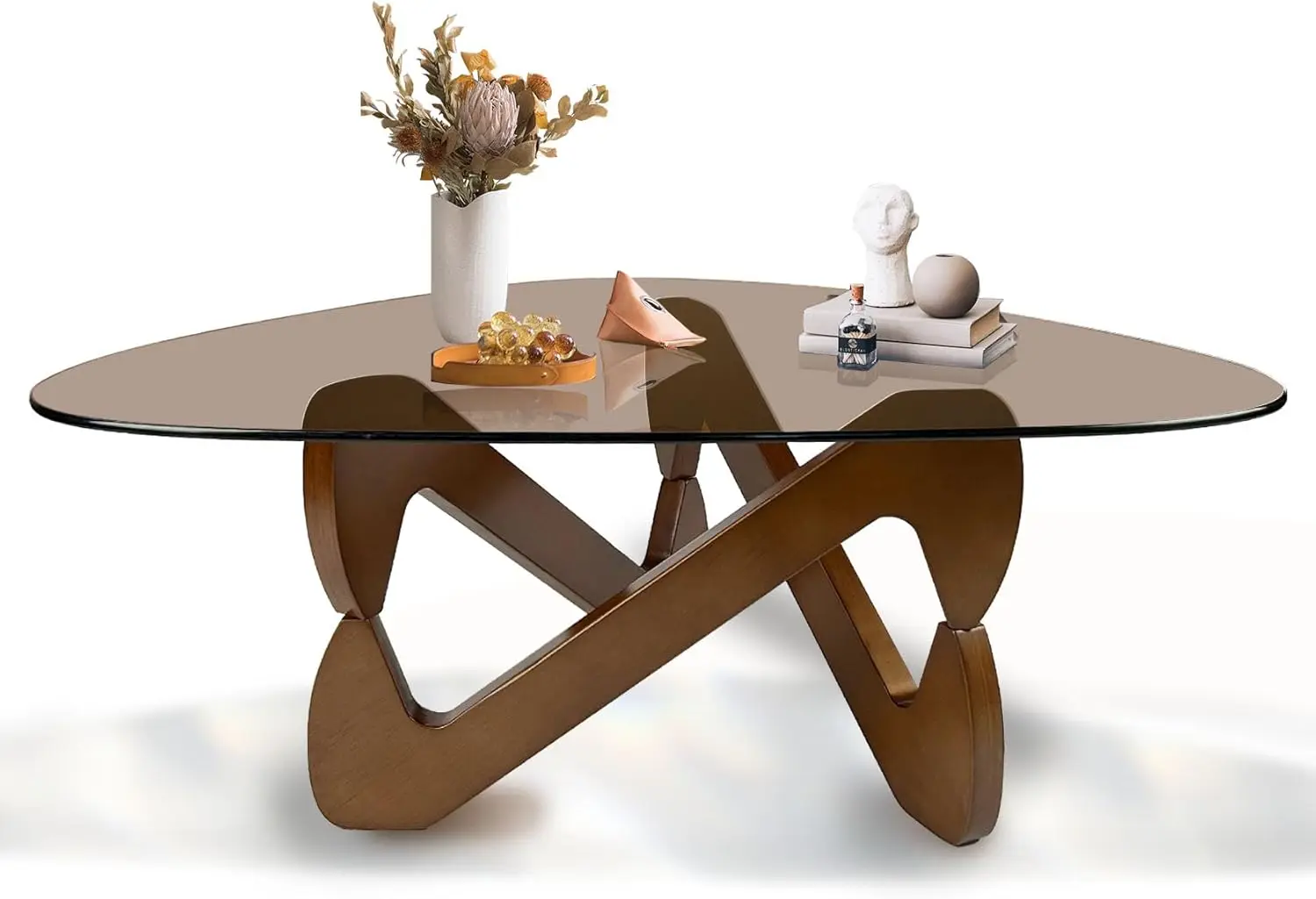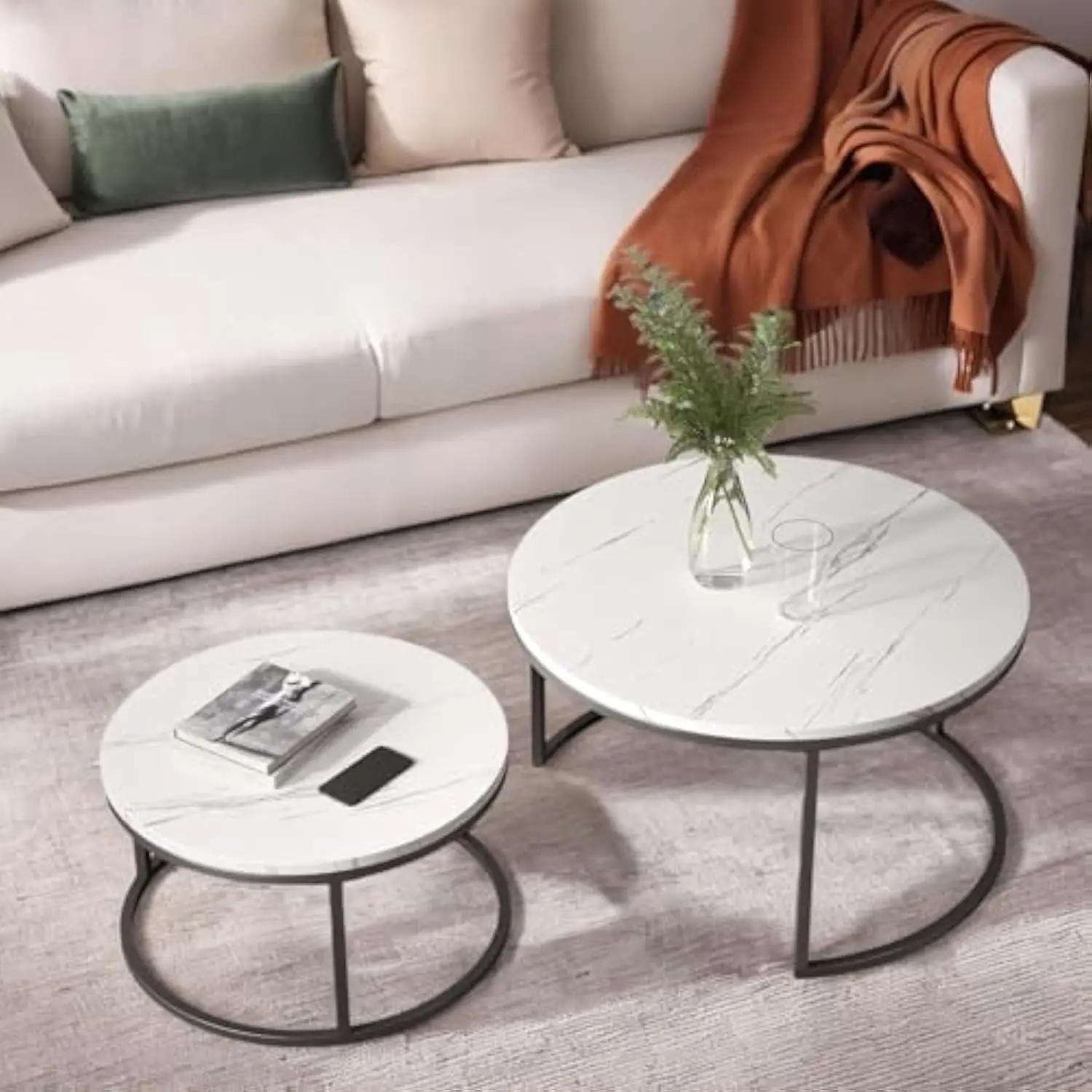At a Glance: Marble vs. Wood Coffee Table Comparison
When choosing between marble and wood coffee tables, understanding their key differences can help you make the right choice for your space. This comparison highlights the essential differences between these two popular materials:
| Feature | Marble Coffee Tables | Wood Coffee Tables |
|---|---|---|
| Aesthetic Appeal | Luxurious, sophisticated, statement piece | Warm, natural, timeless |
| Durability | Resistant to heat, potential for chips and cracks | Susceptible to scratches, can be refinished |
| Maintenance | Requires sealing, sensitive to acids | Needs conditioning, vulnerable to moisture |
| Price Range | $300-$3,000+ | $150-$2,000+ |
| Weight | Heavy (50-150+ lbs) | Moderate (30-80 lbs) |
| Ideal Settings | Modern, minimalist, luxury interiors | Traditional, rustic, mid-century spaces |
The choice between marble and wood goes beyond simple aesthetics. Your lifestyle, maintenance preferences, and even how you plan to use your coffee table all play important roles in determining which material will best serve your needs. For more detailed insights, explore our comprehensive design guide covering all aspects of coffee table materials.
If you’re leaning toward the elegance of natural stone, our mid-century modern marble top coffee tables showcase how this material can become a stunning focal point in your living space.
Why Your Coffee Table Material Choice Matters
Coffee tables are far more than just functional surfaces in your living room. They serve as centerpieces, conversation starters, and daily-use items that impact both the look and livability of your space. The material you choose affects not just the visual appeal of your room, but also how you interact with this piece of furniture on a daily basis.
The Central Role of Coffee Tables
The average coffee table remains in a home for 8-15 years and is among the most frequently used pieces of furniture. It’s where you place drinks, display books, prop up your feet, and sometimes even enjoy casual meals. This daily interaction makes material selection particularly important.
Beyond Appearances
While aesthetics certainly matter, considering how a coffee table functions in your specific lifestyle is equally important. Marble and wood each bring distinct characteristics that influence:
- How you maintain your table
- How it ages over time
- How it complements your existing decor
- How you use it in everyday life
The aesthetic appeal of marble top coffee tables often draws people in initially, but practical considerations should guide your final decision. After all, a beautiful table that doesn’t suit your lifestyle may quickly become a source of frustration rather than enjoyment.
Marble Coffee Tables: Luxurious Statement Pieces
Marble coffee tables have long been associated with elegance and luxury. These sophisticated pieces bring a sense of timelessness and refinement to any living space, instantly elevating the entire room.
What Defines a Marble Coffee Table
Marble coffee tables come in two main forms:
– Solid marble tops: Entire surface made from a single slab or pieces of marble
– Marble veneer: Thin layer of marble applied over another material
The visual impact of marble comes from its distinctive natural patterns and veining. No two pieces are exactly alike, making each marble coffee table a unique creation with its own character and appeal.
Popular Types of Marble
Several varieties of marble are commonly used in coffee tables, each with distinct characteristics:
- Carrara: Light gray background with soft, feathery veining; Italian origin
- Calacatta: White background with dramatic, bold veining; highly prized and more expensive
- Emperador: Rich brown tones with irregular veining; Spanish origin
- Nero Marquina: Deep black background with striking white veins
For more information about these varieties, explore our ultimate guide to marble types for coffee tables.
Current Design Trends
Marble coffee tables remain consistently relevant in interior design, appearing in styles ranging from traditional to ultra-modern. Current trends include:
- Mixing marble with metal accents (brass, gold, or matte black)
- Geometric shapes beyond the traditional rectangle
- Colored marble varieties (green, pink, or blue)
- Dramatic veining as a focal point
The timeless appeal of marble ensures these pieces retain their allure even as other design trends come and go.
Wood Coffee Tables: Timeless Warmth and Character
Wood coffee tables bring natural warmth and organic character to a space. Unlike the cool sophistication of marble, wood offers a welcoming, tactile quality that has made it a perennial favorite in furniture design.
The Natural Appeal of Wood
Wood coffee tables invite touch with their natural grain patterns, organic textures, and inherent warmth. They create a sense of connection to nature and can soften the overall feel of a room, making the space more inviting and comfortable.

Common Wood Types for Coffee Tables
The variety of wood species available offers a spectrum of appearances and characteristics:
Hardwoods:
– Walnut: Rich, chocolate-brown tones with straight grain
– Oak: Strong, light to medium brown with prominent grain
– Maple: Pale, uniform appearance with subtle grain
– Cherry: Reddish-brown that deepens with age
Softwoods:
– Pine: Light, knotty appearance with casual charm
– Cedar: Aromatic with distinctive reddish hues
Engineered Woods:
– Veneers (thin layer of premium wood over substrate)
– Plywood (multiple layers pressed together)
– MDF (medium-density fiberboard)
For a deeper understanding of wood options, check out our guide on hardwood vs. softwood coffee tables.
Finishes and Their Impact
The finish applied to wood significantly affects both appearance and durability:
– Natural oils (penetrating, enhances grain)
– Polyurethane (protective clear coat)
– Lacquer (durable, high-gloss option)
– Wax (traditional, subtle sheen)
Explore our collection of mid-century modern solid wood coffee tables to see how different finishes enhance the natural beauty of wood.
The Advantages of Marble Coffee Tables
Marble coffee tables offer several distinct benefits that make them appealing choices for many homeowners:
• Exceptional Heat Resistance: You can place hot mugs or plates directly on marble without worry of damage, making it practical for entertaining.
• Impressive Longevity: When properly maintained, marble can last for generations, with many antique marble pieces still displaying their original beauty centuries later.
• Scratch Resistance: The hard surface resists the type of everyday scratches that easily mar softer materials.
• Visual Luxury: Marble instantly adds a sense of sophistication and luxury to any space, creating a high-end look that few other materials can match.
• Timeless Appeal: Marble transcends passing trends, remaining stylish and relevant across changing design eras.
• Hygienic Surface: Non-porous when sealed, marble doesn’t harbor bacteria or allergens, making it a healthy choice for households.
• Color Stability: Unlike wood, marble doesn’t darken or change color with age or sun exposure, maintaining its look over decades.
The Drawbacks of Marble Coffee Tables
Despite their beauty, marble coffee tables come with several considerations that might affect your decision:
• Susceptibility to Staining: Marble is naturally porous and can absorb liquids quickly, leading to stains if not promptly cleaned or properly sealed.
• Vulnerability to Acids: Common substances like lemon juice, wine, or coffee can etch the surface, creating permanent dull spots that can’t be polished away.
• Risk of Chipping and Cracking: The edges and corners are particularly vulnerable to damage if something heavy is dropped on them.
• Significant Weight: A marble coffee table can weigh 50-150+ pounds, making it difficult to move and potentially requiring floor reinforcement in some homes.
• Higher Price Point: Quality marble tables typically cost more than comparable wood options, with prices starting higher and increasing dramatically for premium varieties.
• Cold Surface: Marble naturally feels cool to the touch, which can be uncomfortable in colder climates or seasons.
For tips on keeping your marble looking its best, see our guide to cleaning and maintaining marble coffee tables.
The Advantages of Wood Coffee Tables
Wood coffee tables offer numerous benefits that have made them a staple in homes worldwide:
• Natural Warmth and Comfort: Wood creates an inviting, cozy atmosphere and feels pleasant to the touch, unlike cooler materials.
• Repairability: Minor scratches, dents, and wear can often be sanded out and refinished, allowing wood tables to be restored to like-new condition.
• Style Versatility: Wood complements virtually any design aesthetic from rustic farmhouse to sleek contemporary, making it incredibly adaptable.
• Price Accessibility: Available at various price points, wood offers quality options for nearly every budget, from affordable pine to premium walnut.
• Lighter Weight: Most wood coffee tables are significantly lighter than marble, making them easier to move during cleaning or rearranging.
• Eco-Friendly Options: Reclaimed wood and sustainably harvested options provide environmentally conscious choices.
• Natural Variation: Each piece has unique grain patterns, knots, and color variations, ensuring your table is one-of-a-kind.
Explore our collection of popular solid wood coffee table styles to see the variety available.
The Drawbacks of Wood Coffee Tables
Wood coffee tables, despite their popularity, have several limitations to consider:
• Susceptibility to Scratches and Dents: Everyday use can leave marks on the surface, especially with softer wood species.
• Water Sensitivity: Liquid spills can leave permanent ring marks or cause the wood to swell if not promptly dried.
• Sun Damage Risk: Extended exposure to sunlight can cause fading and color changes over time.
• Climate Sensitivity: Wood expands and contracts with humidity changes, potentially leading to warping, cracking, or joint separation.
• Ongoing Maintenance: Regular conditioning with oils or wax is necessary to maintain the wood’s appearance and protect its surface.
• Finish Concerns: Some wood finishes may contain VOCs (volatile organic compounds) that can cause odors or sensitivity in some individuals.

Durability Face-Off: Which Material Lasts Longer?
When comparing the long-term durability of marble and wood coffee tables, each material offers different strengths and weaknesses that affect its lifespan.
Daily Wear and Tear
Marble: Highly resistant to scratches from everyday items but vulnerable to chips and cracks from impacts. Once damaged, repairs are difficult and often visible.
Wood: More likely to show minor scratches and dents from daily use but can often be restored through sanding and refinishing.
Heat and Moisture Resistance
Marble: Excellent heat resistance makes it impervious to hot mugs or plates. However, it can absorb spilled liquids quickly if not properly sealed.
Wood: Susceptible to heat rings from hot items and can be permanently damaged by moisture, which causes swelling, warping, or staining.
Long-term Structural Integrity
Marble: With proper care, marble coffee tables can last for generations. Antique marble pieces hundreds of years old still maintain their functionality and beauty.
Wood: Quality hardwood tables can also last for generations, though they typically require periodic refinishing every 5-10 years to maintain their appearance.
Realistic Lifespan Expectations
With proper care and maintenance:
– High-quality marble tables: 50+ years
– Quality hardwood tables: 20-30+ years before major refinishing, potentially 100+ years with proper care
– Engineered wood tables: 10-15 years
The winner in durability depends largely on your specific concerns and how you’ll use the table. Marble generally wins for heat resistance and longevity without maintenance, while wood offers better repairability when damage does occur.
Maintenance Reality Check: Care Requirements Compared
Understanding the maintenance needs of both materials can help you make a realistic choice based on your willingness to perform regular care.
Daily Care Comparison
| Care Aspect | Marble | Wood |
|---|---|---|
| Daily cleaning | Dust with soft cloth, wipe with damp microfiber cloth | Dust with soft cloth, avoid wet cleaning |
| Spill response | Clean immediately to prevent staining | Wipe immediately to prevent water damage |
| Protective measures | Coasters, placemats recommended | Coasters, placemats essential |
| Cleaning products | pH-neutral cleaners only | Wood-specific cleaners, avoid water-based products |
Periodic Maintenance Tasks
Marble Requirements:
– Resealing every 6-12 months
– Professional polishing if etching occurs
– Specialty marble cleaners for deep cleaning
Wood Requirements:
– Conditioning with oil or wax every 3-6 months
– Light sanding for minor scratches
– Refinishing every 5-10 years depending on wear
Emergency Care
Marble Spill Protocol:
1. Blot (don’t wipe) the spill immediately
2. Clean with pH-neutral soap and water
3. Dry thoroughly with soft cloth
4. For stains, use marble-specific poultice
Wood Spill Protocol:
1. Wipe spill immediately with dry cloth
2. For water rings, try specialized solutions or gentle heat
3. Apply conditioning oil to affected area
4. For deep stains, light sanding may be required
The maintenance commitment is substantial for both materials but differs in nature. Marble requires consistent preventative care, while wood is more forgiving of brief neglect but may need more intensive restoration periodically.
Lifestyle Considerations: Finding Your Perfect Match
Your daily habits and household situation should heavily influence your choice between marble and wood coffee tables.
Homes with Children
Better Choice: Wood
Children are unpredictable, and wood tables better withstand the occasional crayon mark, toy impact, or spilled juice. The forgiving nature of wood means scratches can often be sanded out, and the warmer surface is safer for active children.
Households with Pets
Better Choice: Marble
For pet owners, especially those with dogs or cats, marble offers resistance to claw marks and is easier to clean of pet hair. However, ensure edges are rounded to prevent injury if pets jump up.
Frequent Entertainers
Mixed Recommendation:
– Marble excels for serving drinks and appetizers without worry about heat or ring marks
– Wood creates a warmer, more inviting atmosphere for gatherings
Design Preferences
Modern Minimalist: Marble’s clean lines and luxurious appearance complement contemporary spaces perfectly.
Traditional Home: Wood brings warmth and heritage appeal that suits traditional décor.
Mid-Century Modern: Both materials work well, with wood being historically authentic and marble offering a high-end twist. For styling ideas in this popular aesthetic, see our guide on styling marble coffee tables in mid-century spaces.
Practical Daily Use
If you regularly eat meals at your coffee table, wood might require more diligence with coasters and placemats, while marble better withstands direct contact with plates and mugs but requires prompt cleaning of food spills.
Design Compatibility: Matching Materials to Your Aesthetic
The material of your coffee table significantly impacts how it contributes to your overall interior design scheme.
Marble Complements These Styles:
- Modern & Contemporary: Marble’s sleek, sophisticated appearance pairs perfectly with clean lines and minimalist aesthetics
- Luxury & Glam: The inherent elegance of marble enhances upscale interiors with plush fabrics and metallic accents
- Art Deco: Marble’s geometric potential and luxurious feel align with Art Deco’s bold glamour
- Hollywood Regency: The material’s dramatic presence suits this theatrical, high-end style
Wood Complements These Styles:
- Mid-Century Modern: Authentic to the period, warm wood tones are signature elements
- Rustic & Farmhouse: Wood’s natural character enhances country-inspired interiors
- Traditional: Classic wood pieces bring timeless appeal to traditional spaces
- Scandinavian: Light woods create the bright, airy feeling essential to Nordic design
- Bohemian: Natural materials like wood support the organic, eclectic bohemian aesthetic

Creating Visual Balance
When deciding between marble and wood, consider the visual weight each material brings:
– Marble creates substantial visual weight and becomes a focal point
– Wood blends more naturally with surrounding elements
For alternatives that combine different materials, explore our comparison of glass vs. wood coffee tables which offers insights on mixed-material approaches.
Browse our collection of mid-century modern coffee tables to see how different materials can enhance various design styles.
Investment Value: Price Points and Long-Term Worth
Understanding the financial aspects of your coffee table purchase helps ensure you’re making a sound investment that matches both your budget and long-term needs.
Price Range Comparison
| Quality Level | Marble Coffee Tables | Wood Coffee Tables |
|---|---|---|
| Entry-level | $300-$800 | $150-$500 |
| Mid-range | $800-$1,500 | $500-$1,200 |
| Premium | $1,500-$3,000+ | $1,200-$2,000+ |
Factors Affecting Price
Marble Price Factors:
– Marble type (Carrara typically less expensive than Calacatta)
– Thickness of the marble slab
– Complexity of edge treatments
– Base materials and design
– Size and weight
Wood Price Factors:
– Wood species (walnut and cherry typically cost more than oak or pine)
– Solid wood vs. veneer construction
– Craftsmanship details (joinery, inlays)
– Sustainable sourcing certification
– Finish quality
Value Retention
Quality marble tables generally retain value better than wood over time, with some designer pieces even appreciating. However, condition is critical—damaged marble significantly loses value, while wood can often be restored.
For both materials, choosing classic, timeless designs rather than trendy styles ensures better long-term value and resale potential.
Mid-Century Modern Solid Wood Coffee Tables, Mid-Century Modern Teak Coffee Tables
$879.95 Select options This product has multiple variants. The options may be chosen on the product pageMid-Century Modern Danish Coffee Tables, Mid-Century Modern Oval Coffee Tables, Mid-Century Modern Solid Wood Coffee Tables
$390.05 Select options This product has multiple variants. The options may be chosen on the product pageMid-Century Modern Coffee & End Table Sets, Mid-Century Modern Coffee Table Sets, Mid-Century Modern Oval Coffee Tables
Price range: $257.48 through $331.04 Select options This product has multiple variants. The options may be chosen on the product pageMid-Century Modern Glass Top Coffee Tables, Mid-Century Modern Glass Top Side & End Tables
$460.58 Select options This product has multiple variants. The options may be chosen on the product pageMid-Century Modern Glass Top Coffee Tables, Mid-Century Modern Vintage Coffee Tables, Mid-Century Modern Vintage Side & End Tables
$725.36 Select options This product has multiple variants. The options may be chosen on the product pageMid-Century Modern Lift Top Coffee Tables, Mid-Century Modern Square Coffee Tables
$454.73 Select options This product has multiple variants. The options may be chosen on the product page
Making Your Decision: A Framework for Choosing
To help you navigate this important decision, consider the following questions in sequence:
1. What’s Your Primary Use Case?
- Mostly decorative with light use: Either material works well, choose based on aesthetics
- Daily intensive use (meals, work, kids): Wood may be more practical and forgiving
- Entertaining and serving: Marble handles heat and spills better
- Mixed use: Consider a mixed-material table with wood frame and marble insert
2. What’s Your Maintenance Tolerance?
- Low maintenance preference: Wood requires less immediate attention but periodic refinishing
- Willing to be vigilant: Marble can stay pristine if you’re diligent about preventing stains and etching
- Regular cleaner: Marble is easier to disinfect and clean thoroughly
3. What’s Your Design Priority?
- Warmth and comfort: Wood creates a cozier atmosphere
- Luxury and sophistication: Marble delivers an upscale statement
- Design versatility: Wood adapts to more styles and future décor changes
4. What’s Your Budget Reality?
Be realistic about what you can afford in quality materials. A high-quality wood table is better than a poor-quality marble one, and vice versa.
Alternative Solutions
If you’re torn between options, consider:
– Wood tables with marble insets
– Marble-look materials (quartz, porcelain)
– Wood with glass inserts
For other material options, browse our mid-century modern glass top coffee tables which combine materials for the best of multiple worlds.
Styling Your Coffee Table: Tips for Both Materials
Once you’ve selected your perfect coffee table, styling it appropriately enhances both its beauty and functionality.
For Marble Coffee Tables:
• Protection with Style: Use decorative trays as both design elements and protection for the marble surface
• Color Complements: Choose accessories that highlight the veining colors in your marble
• Visual Balance: Pair the cool tones of marble with warm elements like brass accessories or wood accent pieces
• Texture Contrast: Add soft elements like books, fabric coasters, or small plants to balance marble’s hard surface
For Wood Coffee Tables:
• Enhance Natural Beauty: Choose items that complement the wood tone rather than competing with it
• Strategic Protection: Place stylish coasters and trays where drinks are commonly set
• Finish Enhancement: Use furniture wax or polish regularly to highlight the natural grain
• Complementary Materials: Pair with glass, metal, or ceramic accessories for textural contrast
Both marble and wood coffee tables benefit from the rule of three in styling—grouping decorative items in threes for visual appeal. Additionally, varying heights of accessories creates dynamic interest while maintaining functionality.
Frequently Asked Questions About Coffee Table Materials
Can hot items be placed directly on marble/wood?
Marble can handle hot items without damage. Wood should always be protected with trivets or coasters to prevent heat rings.
How do I remove water rings from wood?
Minor water rings can often be removed by applying a mixture of equal parts white vinegar and olive oil with a soft cloth, rubbing with the grain. For stubborn rings, light sanding and refinishing may be necessary.
Will my marble coffee table eventually yellow?
Quality marble won’t yellow over time. However, some lower-quality marble may show slight yellowing, particularly white varieties. Regular cleaning helps prevent this issue.
Which wood species is most scratch-resistant?
Hard maple and white oak rank among the most scratch-resistant domestic woods for furniture, with hickory and walnut following closely behind.
How heavy is a typical marble coffee table?
A standard marble coffee table (48” × 24”) typically weighs between 80-150 pounds, depending on the thickness of the marble and the base construction.
Can I refinish my wood coffee table myself?
Yes, most wood coffee tables can be refinished by DIY enthusiasts with basic tools. The process typically involves sanding the existing finish, cleaning thoroughly, and applying new stain and protective topcoat.
By weighing all these factors—from aesthetics to practicality, maintenance to budget—you’ll be well-equipped to choose between marble and wood for your ideal coffee table. The perfect choice ultimately depends on your unique lifestyle, preferences, and the specific demands of your space.







